Related Research Articles
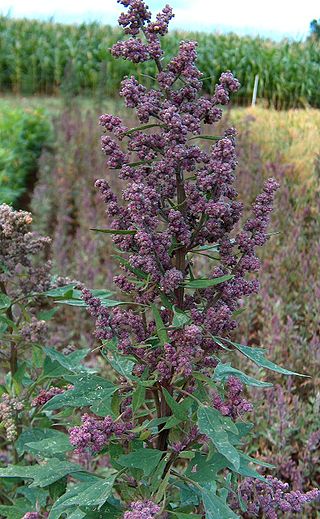
Quinoa is a flowering plant in the amaranth family. It is an herbaceous annual plant grown as a crop primarily for its edible seeds; the seeds are rich in protein, dietary fiber, B vitamins and dietary minerals in amounts greater than in many grains. Quinoa is not a grass but rather a pseudocereal botanically related to spinach and amaranth, and originated in the Andean region of northwestern South America. It was first used to feed livestock 5,200–7,000 years ago, and for human consumption 3,000–4,000 years ago in the Lake Titicaca basin of Peru and Bolivia.
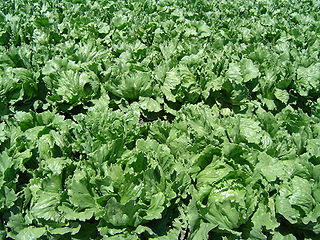
Lettuce is an annual plant of the family Asteraceae. It is most often grown as a leaf vegetable, but sometimes for its stem and seeds. Lettuce is most often used for salads, although it is also seen in other kinds of food, such as soups, sandwiches and wraps; it can also be grilled. One variety, celtuce, is grown for its stems, which are eaten either raw or cooked. In addition to its main use as a leafy green, it has also gathered religious and medicinal significance over centuries of human consumption. Europe and North America originally dominated the market for lettuce, but by the late 20th century the consumption of lettuce had spread throughout the world. As of 2021, world production of lettuce and chicory was 27 million tonnes, 53 percent of which came from China.

The radish is an edible root vegetable of the mustard family, Brassicaceae, that was domesticated in Asia prior to Roman times.
In agriculture, succession planting refers to several planting methods that increase crop availability during a growing season by making efficient use of space and timing.
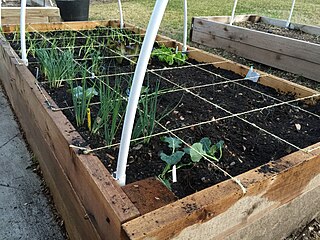
Square foot gardening is the practice of dividing the growing area into small square sections, typically 1 foot (30 cm) on a side, hence the name. The aim is to assist the planning and creating of a small but intensively planted vegetable garden. It results in a simple and orderly gardening system, from which it draws much of its appeal. Mel Bartholomew coined the term "square foot gardening" in his 1981 book of the same name.

A market garden is the relatively small-scale production of fruits, vegetables and flowers as cash crops, frequently sold directly to consumers and restaurants. The diversity of crops grown on a small area of land, typically from under 0.40 hectares to some hectares, or sometimes in greenhouses, distinguishes it from other types of farming. A market garden is sometimes called a truck farm in the USA.

Seed companies produce and sell seeds for flowers, fruits and vegetables to commercial growers and amateur gardeners. The production of seed is a multibillion-dollar business, which uses growing facilities and growing locations worldwide. While most of the seed is produced by large specialist growers, large amounts are also produced by small growers that produce only one to a few crop types. The larger companies supply seed both to commercial resellers and wholesalers. The resellers and wholesalers sell to vegetable and fruit growers, and to companies who package seed into packets and sell them on to the amateur gardener.

Leaf vegetables, also called leafy greens, pot herbs, vegetable greens, or simply greens, are plant leaves eaten as a vegetable, sometimes accompanied by tender petioles and shoots. Leaf vegetables eaten raw in a salad can be called salad greens.

Washington Atlee Burpee was the founder of the W. Atlee Burpee & Company, now more commonly known as Burpee Seeds.

An heirloom plant, heirloom variety, heritage fruit, or heirloom vegetable is an old cultivar of a plant used for food that is grown and maintained by gardeners and farmers, particularly in isolated communities of the Western world. These were commonly grown during earlier periods in human history, but are not used in modern large-scale agriculture.
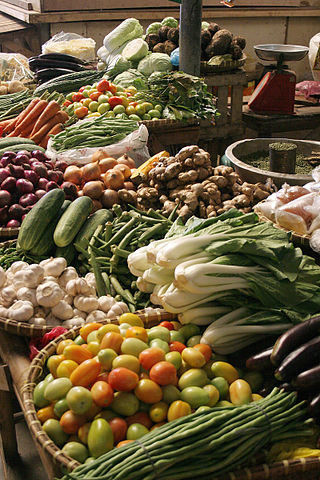
Vegetables are parts of plants that are consumed by humans or other animals as food. The original meaning is still commonly used and is applied to plants collectively to refer to all edible plant matter, including the flowers, fruits, stems, leaves, roots, and seeds. An alternative definition of the term is applied somewhat arbitrarily, often by culinary and cultural tradition. It may exclude foods derived from some plants that are fruits, flowers, nuts, and cereal grains, but include savoury fruits such as tomatoes and courgettes, flowers such as broccoli, and seeds such as pulses.
Southern Exposure Seed Exchange (SESE) is a cooperatively-owned seed company. SESE is a source for heirloom seeds and other open-pollinated (non-hybrid) seeds with an emphasis on vegetables, flowers, and herbs that grow well in the Mid-Atlantic region. SESE also supports seed saving and traditional seed breeding through their product line, through lectures and workshops, and by working with over 50 small seed-growing farmers in the Mid-Atlantic and other parts of the United States. SESE publishes an intermittent email newsletter and blog for gardeners, as well as the Southern Exposure Seed Exchange Catalog and Garden Guide.

Watermelon is a flowering plant species of the Cucurbitaceae family and the name of its edible fruit. A scrambling and trailing vine-like plant, it is a highly cultivated fruit worldwide, with more than 1,000 varieties.
The Student Sustainable Farm at Rutgers is located at Rutgers' Horticultural Research Station in New Brunswick, New Jersey, on the G. H. Cook campus of Rutgers University.

Plant breeding is the science of changing the traits of plants in order to produce desired characteristics. It has been used to improve the quality of nutrition in products for humans and animals. The goals of plant breeding are to produce crop varieties that boast unique and superior traits for a variety of applications. The most frequently addressed agricultural traits are those related to biotic and abiotic stress tolerance, grain or biomass yield, end-use quality characteristics such as taste or the concentrations of specific biological molecules and ease of processing.
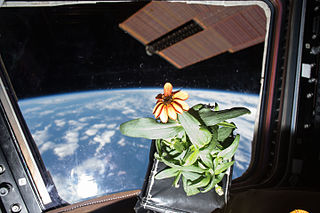
The growth of plants in outer space has elicited much scientific interest. In the late 20th and early 21st century, plants were often taken into space in low Earth orbit to be grown in a weightless but pressurized controlled environment, sometimes called space gardens. In the context of human spaceflight, they can be consumed as food and/or provide a refreshing atmosphere. Plants can metabolize carbon dioxide in the air to produce valuable oxygen, and can help control cabin humidity. Growing plants in space may provide a psychological benefit to human spaceflight crews. Usually the plants were part of studies or technical development to further develop space gardens or conduct science experiments. To date plants taken into space have had mostly scientific interest, with only limited contributions to the functionality of the spacecraft, however the Apollo Moon tree project was more or less forestry inspired mission and the trees are part of a country's bicentennial celebration.
The Open Source Seed Initiative (OSSI) is an organization that developed and maintains a mechanism through which plant breeders can designate the new crop varieties they have bred as open source. This mechanism is advanced as an alternative to patent-protected seeds sold by large agriculture companies such as Monsanto or DuPont. OSSI is a U.S. based not-for-profit 501(c)(3) organization focusing on establishing a protected commons of open source varieties and on educational and outreach activities associated with the development of this open source seed commons and on seed rights and issues related to the control of seed.

The Vegetable Production System (Veggie) is a plant growth system developed and used by NASA in outer space environments. The purpose of Veggie is to provide a self-sufficient and sustainable food source for astronauts as well as a means of recreation and relaxation through therapeutic gardening. Veggie was designed in conjunction with ORBITEC and is currently being used aboard the International Space Station, with another Veggie module planned to be delivered to the ISS in 2017.

Honeynut squash is an interspecific hybrid winter squash cultivar bred from butternut and buttercup squash. It has dark tan to orange skin with orange fleshy pulp. When ripe, it turns from green to a deep orange and becomes sweeter and richer. Honeynut squash has a similar shape and flavor to butternut squash but averages about half the size and is sweeter. It has two to three times more beta-carotene than butternut squash. Honeynut squash can be roasted, sautéed, puréed, added to soups, stews, and braises, and has enough sugar content for desserts.
References
- 1 2 3 Bock, Paula (April 17, 2005). "The Seed Saver: In plant propagation, our past and future are preserved". The Seattle Times . Retrieved 1 January 2022.
- ↑ Charles, Dan (January 24, 2011). "A Tale Of Two Seed Farmers: Organic Vs. Engineered". NPR . Retrieved 1 January 2022.
- 1 2 Greenwood, Veronique (August 13, 2021). "The man growing lettuce for space station salads". BBC Future . Retrieved 1 January 2022.
- 1 2 Idlebrook, Craig (Aug 21, 2020). "Better Heirloom Vegetables". Mother Earth News . Retrieved 1 January 2022.
- ↑ Goldman, Irwin (Nov 10, 2020). Plant Breeding Reviews, Volume 44. John Wiley & Sons. p. 141. ISBN 9781119716952 . Retrieved 1 January 2022.
99 of the 104 lettuce varieties were bred by Frank Morton, for whom leafy greens, especially lettuce, is his major focus.
- 1 2 Cernansky, Rachel (December 12, 2016). "How "open source" seed producers from the U.S. to India are changing global food production". Ensia. University of Minnesota . Retrieved 1 January 2022.
- ↑ Boyle, Alan (August 10, 2015). "Space station crew chows down on fresh Outredgeous lettuce … and so can you". GeekWire. Retrieved 1 January 2022.
- ↑ Brownlee, Lisa (1 January 2022). "International Space Station Astronauts Look Forward To Today's First Taste Of Space Harvest". Forbes . Retrieved 26 February 2016.
- 1 2 Levin, Rachel (Dec 15, 2015). "The Outsize Importance of the Tiny Organic Seed". Modern Farmer. Retrieved 1 January 2022.
- ↑ Bland, Alastair (November 29, 2012). "Quinoa Craze Inspires North America To Start Growing Its Own". NPR . Retrieved 1 January 2022.